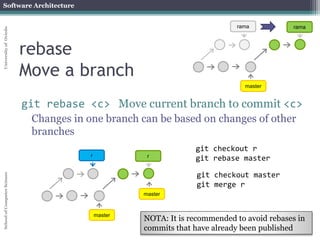

- #Git rebase on another branch how to#
- #Git rebase on another branch update#
- #Git rebase on another branch code#
The syntax means "the last known state of feature1 before the rebase" and requires reflogging to be enabled (the default for non-bare repositories). This will rebase all commits of feature2 that follow the old head of feature1 (i.e. The solution is to use git rebase -onto after rebasing the first branch. They are both used in different scenarios.
#Git rebase on another branch code#
In the worst case you might mess up your code with unnecessary conflicts. Rebasing and merging are both used to integrate changes from one branch into another differently. Depending on the complexity of your branches and the number of commits this might be at least tedious to solve using git rebase -skip to skip the right commits. The commits D, E, F and D', E', F' will get you into trouble. So you start rebasing feature1 on master: $ git rebase master feature1Īnd the result looks like this: master -A-B-Cĭoing another plain rebase of feature2 on feature1 might be problematic, because they share a similar, but not the same history. Merge is always a forward moving change record. The other change integration utility is git merge. Sooner or later you might also run into situations where you want to rebase a branch that itself has child branches. Rebase is one of two Git utilities that specializes in integrating changes from one branch onto another. Other developers should be able to see the merge commit, source, and target branch details.Git encourages you to use branches and depending on your workflow you might get pretty complex commit histories. The first image below is the branch diagram of the GitHub repository used in this example.
#Git rebase on another branch how to#
You should issue a merge request when you want your code to merge into the main source branch. In this tutorial on how to rebase GitHub, we will clone a repository that has both a master and a feature branch, rebase those branches and demonstrate some of the challenges associated with a push of a rebased GitHub repo to the server. You don’t need others to know at which point code for merged. git/rebase-apply working files, use the command git rebase -abort instead.
#Git rebase on another branch update#
You should use “git rebase” when you want to update your code from a source branch and do your work on top of it. To check out the original“get merge” would preserve the history of the merge. Commits will appear merged into the original list of commits.

“git merge” creates a new hash commit here ( f74196a) and applies that. The commits may appear anywhere in the git log. git rebase git merge ~/repoone$ git log –onelineĪ5658c7 (HEAD -> main) Commit after maincopy created and having it’s own commitsį74196a (HEAD -> main) Merge branch ‘maincopy’ into mainī831147 Commit after maincopy created and having it’s own commitsĢ673111 Initial commit “git rebase” rewinds HEAD and would apply the commits one after another.
To check out the originalAnother option is to bypass the commit that caused the merge failure with git rebase -skip.

Listed below are differences between git rebase and git merge based on the outputs above. You will have to resolve any such merge failure and run git rebase -continue. Let us see this in a real-life example and hands-on.įirst, rewinding head to replay your work on top of it.Īpplying: Commit after maincopy created and having it's own commitsĪ5658c7 (HEAD -> main) Commit after maincopy created and having it's own commitsĥ9968f9 (maincopy) Second local commit of maincopyĩ08d6ac (origin/main, origin/HEAD) Third commit in main Your new commits will go on top of existing commits in main branch. But history before that should be common. Source main can have other commits after maincopy diverged from main. The history of commits before your new local commits is common in source and target branches. You want these changes to go into the online repository. The aim of this article is to introduce git rebase, a command that helps integrate branches by moving a sequence of commits from a source branch on top of a. You have extra code in the form of commits in your branch maincopy that you want to get into the online repository’s branch. When you raise a pull request, what you are requesting is this. git mergeĪs seen above, you would work in your local copy and keep adding commits in your local branch. You can use “git rebase” whenever you want to guarantee that all the commits (code changes) of one branch are present in another. 59968f9 (HEAD -> maincopy) Second local commit of maincopyĩ08d6ac (origin/main, origin/HEAD, main) Third commit in mainĪbove is a typical usage scenario.


 0 kommentar(er)
0 kommentar(er)
